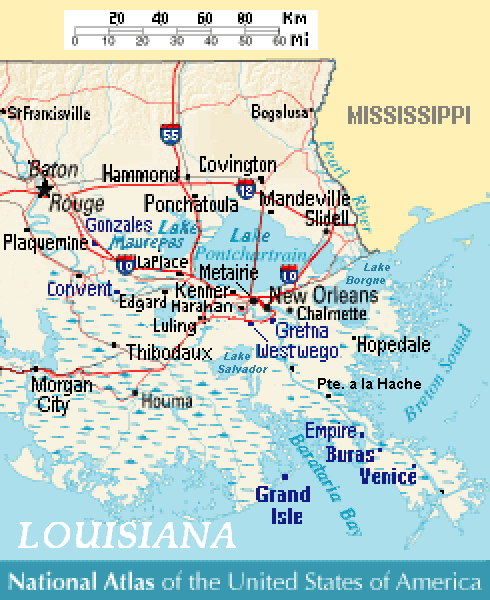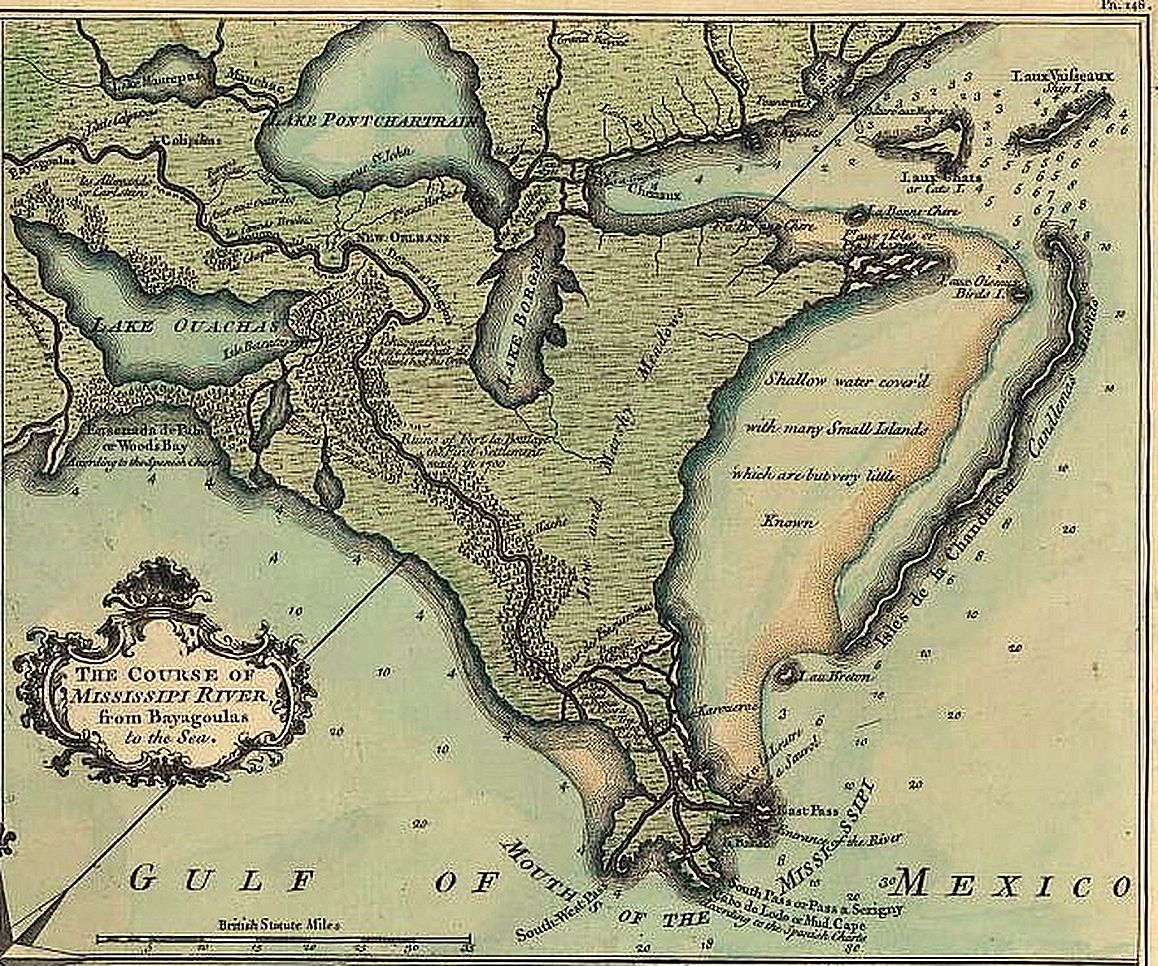Lake Borgne on:
[Wikipedia]
[Google]
[Amazon]
Lake Borgne (french: Lac Borgne, es, Lago Borgne) is a

 The Mississippi River
The Mississippi River
lagoon
A lagoon is a shallow body of water separated from a larger body of water by a narrow landform, such as reefs, barrier islands, barrier peninsulas, or isthmuses. Lagoons are commonly divided into '' coastal lagoons'' (or ''barrier lagoons ...
of the Gulf of Mexico
The Gulf of Mexico ( es, Golfo de México) is an ocean basin and a marginal sea of the Atlantic Ocean, largely surrounded by the North American continent. It is bounded on the northeast, north and northwest by the Gulf Coast of the United ...
in southeastern Louisiana
Louisiana , group=pronunciation (French: ''La Louisiane'') is a state in the Deep South and South Central regions of the United States. It is the 20th-smallest by area and the 25th most populous of the 50 U.S. states. Louisiana is bord ...
. Although early maps show it as a lake
A lake is an area filled with water, localized in a basin, surrounded by land, and distinct from any river or other outlet that serves to feed or drain the lake. Lakes lie on land and are not part of the ocean, although, like the much large ...
surrounded by land, coastal erosion has made it an arm of the Gulf of Mexico. Its name comes from the French
French (french: français(e), link=no) may refer to:
* Something of, from, or related to France
** French language, which originated in France, and its various dialects and accents
** French people, a nation and ethnic group identified with Franc ...
word ''borgne'', which means "one-eyed."
Geography
In southern Louisiana, three large lakes— Maurepas, Pontchartrain, and Borgne—cover 55% of the Pontchartrain Basin. Abrackish marsh
Brackish marshes develop from salt marshes where a significant freshwater influx dilutes the seawater to brackish levels of salinity. This commonly happens upstream from salt marshes by estuaries of coastal rivers or near the mouths of coastal riv ...
land bridge and Lake St. Catherine separate Lake Pontchartrain from Lake Borgne. The Rigolets
Rigolets is a 12.9 kilometer (8 mi) long deepwater strait in Louisiana. "Rigolets" comes from the word ''rigole'', French for 'trench' or 'gutter'. The name is now locally pronounced "RIG-uh-leez".
The strait begins at and follows a gener ...
and Chef Menteur Pass are the two open water connections between Pontchartrain and Borgne.

Coastal erosion
Coastal erosion is the loss or displacement of land, or the long-term removal of sediment and rocks along the coastline due to the action of waves, currents, tides, wind-driven water, waterborne ice, or other impacts of storms. The landwar ...
has transformed Borgne into a lagoon connecting to the Gulf of Mexico. Early 18th-century maps show Borgne as a true lake, largely separated from the gulf by a considerable extent of wetland
A wetland is a distinct ecosystem that is flooded or saturated by water, either permanently (for years or decades) or seasonally (for weeks or months). Flooding results in oxygen-free (Anoxic waters, anoxic) processes prevailing, especially in t ...
s that have since disappeared. In a 1902 case before the United States Supreme Court
The Supreme Court of the United States (SCOTUS) is the highest court in the federal judiciary of the United States. It has ultimate appellate jurisdiction over all U.S. federal court cases, and over state court cases that involve a point o ...
over the oyster
Oyster is the common name for a number of different families of salt-water bivalve molluscs that live in marine or brackish habitats. In some species, the valves are highly calcified, and many are somewhat irregular in shape. Many, but not ...
banks at the boundary between Louisiana and Mississippi, the State of Mississippi argued that at the time of Louisiana's admission into the Union, there probably was no such "Lake Borgne" or "Mississippi Sound".
The basin contains 483,390 acres (1956 km2) of wetlands, consisting of nearly 38,500 acres (156 km2) of fresh marsh, 28,600 acres (116 km2) of intermediate marsh, 116,800 acres (473 km2) of brackish marsh, 83,900 acres (340 km2) of saline marsh, and 215,600 acres (873 km2) of cypress swamp. Since 1932, more than 66,000 acres (267 km2) of marsh have converted to water in the Pontchartrain Basin—over 22% of the marsh that existed in 1932.
The primary causes of wetland loss in the basin are the effects of natural changes to the topography over time and can and will change in the future, the hydrological isolation of the Mississippi River from its floodplains (which deprives the coast of sediment needed to build and sustain land), and the extensive cutting and channelization of coastal wetlands (which destabilizes existing land, hastening the transition to open water).
In response to the extensive damage from Hurricane Katrina
Hurricane Katrina was a destructive Category 5 Atlantic hurricane that caused over 1,800 fatalities and $125 billion in damage in late August 2005, especially in the city of New Orleans and the surrounding areas. It was at the time the cost ...
in 2005, the Army Corps of Engineers constructed the 1.8-mile-long (2.9 km) IHNC Lake Borgne Surge Barrier, as part of the Hurricane & Storm Damage Risk Reduction System
The greater New Orleans Hurricane & Storm Damage Risk Reduction System (HSDRRS) is an infrastructure systems in southern Louisiana which seeks to provide the greater New Orleans area a 100-year level of risk reduction, meaning reduced risk from a ...
for southeast Louisiana. The project cost approximately $1.1 billion and was built at the confluence of the Gulf Intracoastal Waterway
The Gulf Intracoastal Waterway is the portion of the Intracoastal Waterway located along the Gulf Coast of the United States. It is a navigable inland waterway running approximately from Carrabelle, Florida, to Brownsville, Texas.
The waterwa ...
and the Mississippi River Gulf Outlet
Mississippi () is a state in the Southeastern region of the United States, bordered to the north by Tennessee; to the east by Alabama; to the south by the Gulf of Mexico; to the southwest by Louisiana; and to the northwest by Arkansas. Missis ...
(MRGO). It is the largest design-build civil works project in the history of the Corps. It was first used in 2012 to protect against storm surge from Hurricane Isaac and was fully completed in 2013.
Ecology
 The Mississippi River
The Mississippi River levee
A levee (), dike (American English), dyke (Commonwealth English), embankment, floodbank, or stop bank is a structure that is usually earthen and that often runs parallel to the course of a river in its floodplain or along low-lying coastli ...
s significantly limit the input of fresh water, sediment, and nutrients into the Pontchartrain basin. This reduction in freshwater input plays a role in the critical problem of the Pontchartrain Basin—increased salinity
Salinity () is the saltiness or amount of salt (chemistry), salt dissolved in a body of water, called saline water (see also soil salinity). It is usually measured in g/L or g/kg (grams of salt per liter/kilogram of water; the latter is dimensio ...
. The construction of the MRGO, which breaches the natural barrier of the Bayou La Loutre ridge and the Borgne land bridge, has allowed sea water to push farther into the basin. Relative sea level rise
Globally, sea levels are rising due to human-caused climate change. Between 1901 and 2018, the globally averaged sea level rose by , or 1–2 mm per year on average.IPCC, 2019Summary for Policymakers InIPCC Special Report on the Ocean and Cr ...
of up to 0.96 feet per century also gives saltier waters greater access to surrounding wetlands. As a result, mean monthly salinities have increased since the construction of the MRGO and other canals. In recent years, salinities have stabilized. The heightened salinity has stressed wetlands, especially freshwater marshes and swamps.
Since 1932, approximately 24% of the Borgne Land Bridge has been lost to severe shoreline retreat and rapid tidal fluctuations, and the loss rate is increasing. During the same time, 17% of the Maurepas Land Bridge marshes disappeared because of subsidence
Subsidence is a general term for downward vertical movement of the Earth's surface, which can be caused by both natural processes and human activities. Subsidence involves little or no horizontal movement, which distinguishes it from slope mov ...
and spikes in lake salinity. These land bridges prevent estuarine processes, such as increased salinity and tidal scour, from pushing further into the middle and upper basins. Additionally, from 1968 to 1988, 32% of the cypress swamp on the land bridge had either converted to marsh or became open water. If these buffers are not preserved, the land loss rates around Lakes Pontchartrain and Maurepas will increase dramatically. Several marshes in the basin are vulnerable to rapid loss if adequate protection is not quickly provided.
References
External links
* {{Authority control Bodies of water of Hancock County, Mississippi Bodies of water of Orleans Parish, Louisiana Bodies of water of St. Bernard Parish, Louisiana Bodies of water of St. Tammany Parish, LouisianaBorgne
Borgne (; ht, Obòy) is a commune in the Borgne Arrondissement, in Nord department of Haiti. The economy there is based on agriculture and fishery. Other nearby places include Port-Margot, Robin, and Fond La Grange. Borgne is currently in th ...
Intracoastal Waterway
Bodies of water of Mississippi
Borgne
Borgne (; ht, Obòy) is a commune in the Borgne Arrondissement, in Nord department of Haiti. The economy there is based on agriculture and fishery. Other nearby places include Port-Margot, Robin, and Fond La Grange. Borgne is currently in th ...
Estuaries of Louisiana